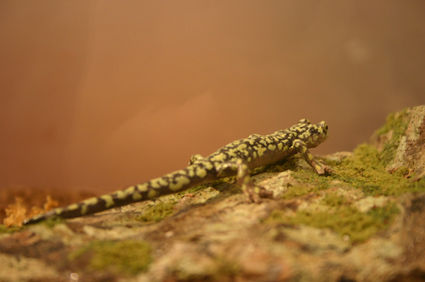Green salamander
The green salamander (Aneides aeneus) is a species of lungless salamander in the Plethodontidae family. It is native to the Appalachian mountain range and favors rock crevices and fallen logs in moist temperate forests. Alabama and some parts of Northern Mississippi represent the southernmost range of the amphibian which is an important carnivorous link in the forest ecosystem.
The green salamander is a slimy, mottled amphibian with bulging eyes and dark green and yellow-green blotchy skin tending toward pink on its limbs. They are therefore well-camouflaged among lichen-covered moist rocks. The young are born from eggs secreted in rock crevices or under bark in large downed logs or stumps. They are typically attended by the mother for about a month before moving out onto outcrops in search of mites and other small insects. The salamanders take as much as three years to reach sexual maturity.
Adults, about 5.5 inches long, are nocturnal and tend to stay sheltered under rocks or in caverns, especially during the hottest, driest periods of the year. They feed on smails, slugs, spiders and small insects. Adults migrate within their range before and after those hibernation seasons and establish and defend territory from other males for reproduction. The lifespan of the green salamander is not known for certain, but is conjectured at about 10 years. Common predators of salamanders include garter and ring-necked snakes and likely larger salamanders.
As a species, the green salamander is uncommon and classified as "near threatened" by the International Union for Conservation of Nature. Leslie Rissler, a herpetologist at the University of Alabama, studies native salamanders in the Bankhead National Forest.
References
- Cline, George R. (2008) "Green Salamander" Alabama Department of Conservation and Natural Resources
- Pauley, Thomas K. and Mark B. Watson (2009) "Aneides aeneus" Amphibiaweb
- Spencer, Thomas (August 23, 2009) "Alabama among the best places to study salamanders." Birmingham News
